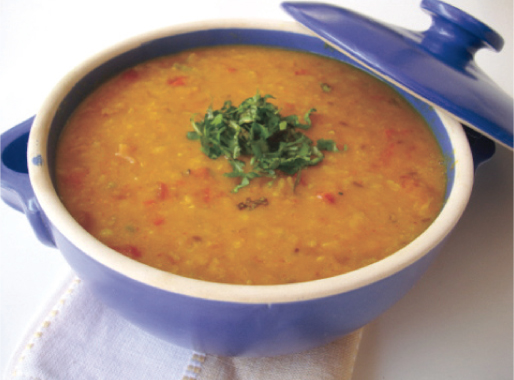Mama’s Punjabi Recipes – Dhuli Mah Chole Di Dal (Skinless Split Urad And Split Chana Dal)
This is a variation on the most beloved of all dal dishes for Punjabis, and a welcome change from the brown chocolate colored Dal Makhani (Butter Lentils) which is found in just about every Indian restaurant and dhaba around the world. It combines the flavor pf the black urad dal – but without the bitter taste of its skin – and the yellow chana or chola dal (without the skin).
Most Punjabis will argue that the skin on the urad dal adds fiber and protein to the finished dal dish, but many will tell you that the skinless variety makes the dish sweeter and allows adding more spices to enhance the flavor. Most dals are made alone, by themselves and not mixed with others. The urad-chole dal combination is considered unique to the Punjab by tempering the soft starchiness of the urad dal with the hardiness of the chole dal.
But when the urad dal is skinless it tends to cook even faster, so you have to be very careful that it does not dissolve into a soupy liquid and doesn’t taste like a dal. This dal should not be made in a pressure cooker or all you will get is a thin soup! The chana dal should be cooked first and then the urad dal added to it.
This dal goes well with many other dishes, rice and rotis and condiments, like achaars and red onions, without imposing a strong flavor and should cooked with a little hing (asafetida) to assist in digestion and add flavor and garnished at the end with garam masala and coriander. If you prefer, you can use powdered ginger and garlic
Ingredients:
1 cup skinless split urad dal
1 cup skinless split chana dal
4 cups pani (water)
2 tbspn olive oil
1 tspn garam masala
5 stalktops fresh dhania (coriander) – pinch off the leaves and cut into pieces
Spices: lal mirch (red pepper); namak (salt); haldi (turmeric) – to your taste
Ingredients for curry masala:
1 large pyaaz (onion) – peeled and chopped
4 cloves of lasan (garlic) – peeled and chopped, or use powdered garlic
1 medium adrak (ginger) – peeled and chopped, or use powdered ginger
1 pinch of hing (asafetida)
½ cup water
Directions:
1. It is important to prepare the chana dal first. You can either soak the chana dal for an hour in water and then cook it with the urad dal or place the chana dal and water in a pot on the stove and bring to boil for 10 minutes until it is a little tender.
2. Pour the urad dal into the pot and add the ginger, garlic, and spices
3. Bring to boil for 15 minutes, if needed add more water but this dal should not be runny. Let the dal mix well, the grains of urad and chana dal should not appear separated but the dish should not appear too thick. The grains should be soft but not mushy. Be careful that the dal does not stick to the bottom of the pot and burn. Turn off the heat.
4. Heat the oil in a small karai or wok and add the curry masala spices and water and brown it a little. When roasted and the smell of the pieces starts to come through take off the heat and drop the masala into the pot of cooked dal and stir to mix well.
5. Sprinkle the top of the dal with garam masala and the cut coriander leaves above.
MAMA’S TIP OF THE WEEK
HOW NOT TO MAKE WATERY DALS
There have been many times when the dal that is served is watery and very thin, with the individual grains either sunk to the bottom or the entire dish is like a soup. This is not the Punjabi style of cooking dals, as the dish should be thick, the grains visible and it should be able to be scooped up with a piece of naan, roti or parantha.
The reason that the dal becomes a soup is that it has been cooked for too long over high heat or in a pressure cooker to speed up the cooking time. Be aware of the density of each type of dal and then cook them accordingly. Most dals do not need to be cooked in a pressure cooker, instead they should be cooked for 10 to 15 minutes over medium high heat – later reduced to medium low – in a pot.
****
Shakuntla Malhotra is a skilled cook of Punjabi dishes made in the old-fashioned style that she learnt as a young woman in her ancestral home in Lyallpur, India before it became part of Pakistan after the Partition in 1947. People have often admired her cooking for its simplicity and taste that comes with each mouthful. Even in her mid-eighties, she continues to cook daily and agreed to share some of her delectable Punjabi recipes.


